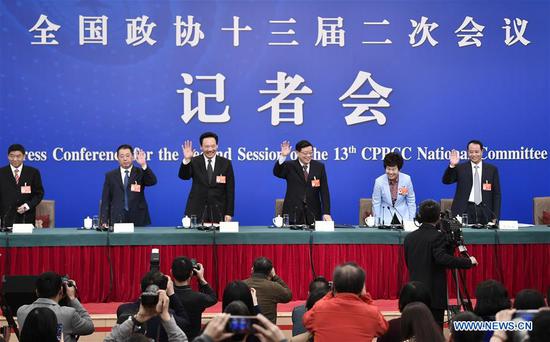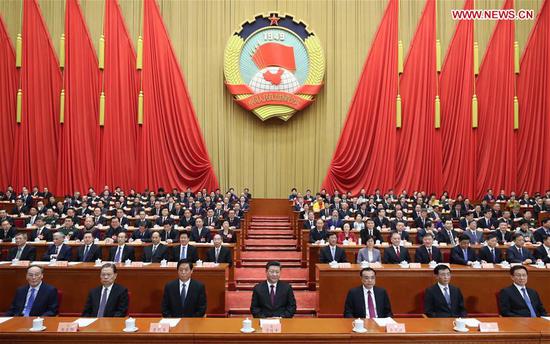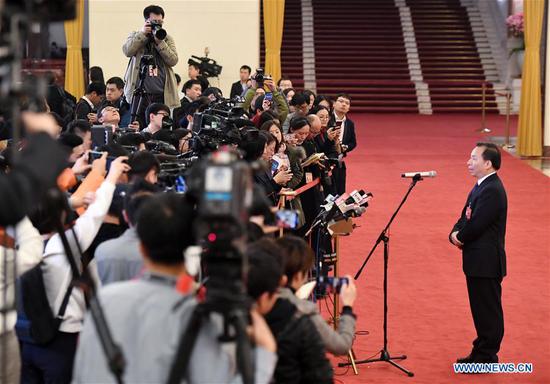
Chinese students take part in a graduation ceremony at Columbia University in New York last year. (GUO KE/XINHUA)
Decline in new enrollments leads to budget cuts
Nearly 1.1 million international students are studying at universities and colleges in the United States, contributing $42 billion to the country's economy. For every seven international students enrolled, three U.S. jobs are created and supported through tuition and other expenses.
However, the years of easy growth may be over for many of the schools as new enrollment of international students has declined for a third consecutive year.
New student enrollments fell from the 2016-17 academic year by 6.6 percent for the 2017-18 period, according to a new study.
However, overall-as opposed to new-international enrollments increased by 1.5 percent from 2016-17 to 2017-18, according to a survey last year by the Institute of International Education in New York. It collected data from 2,075 institutions.
The report also found that most of the international students are from China, with more than 363,000 enrolling in the 2017-2018 school year, or about one-third of the total international student population in the U.S..
Several states, including Arkansas, Montana and Tennessee, saw their international student numbers decline by double digits.
The universities of Illinois, Oregon and Iowa reported enrollment declines among international students for the fall last year, especially from China, the largest contributor to the U.S..
Rahul Choudaha, research associate at the Center for Studies in Higher Education at the University of California, Berkeley, said the loss of Chinese students, who often pay higher tuition rates, would be financially catastrophic for U.S. universities.
As an example, he cited Michigan State University, which enrolled 486 fewer undergraduate students from China in the fall semester last year.
Based on the university's annual $40,000 international undergraduate tuition fee, 486 fewer students means a loss of nearly $20 million in revenue in the first year and $80 million in four years, Choudaha said.
"Public universities are even more dependent on international students, especially those from China, because of the decline in domestic enrollment and the government's budgetary support," he said.
At UC Berkeley, China provides the largest number of foreign students, accounting for more than 37 percent of the international total. In the fall, the university had 2,448 Chinese students, 169 more than at the same time the previous year, a rise of 7.42 percent. Tuition and fees for international undergraduates are $46,170 a year, according to the university's international office.
The fall in international enrollments has led to budget cuts at some institutions. Wright State University in Ohio has reduced the number of full-time French horn and tuba professors, and Kansas State University has reduced its Italian classes, according to media reports.
Two colleges at the University of Illinois have insured themselves against a sharp drop in the number of Chinese students, to manage financial risks to their programs.
Jeffrey Brown, dean of the university's business college, came up with the idea in 2015, when international enrollments were high.
In 2017, Brown's college and the engineering college agreed to pay $424,000 annually for insurance coverage of up to $60 million-about the combined annual tuition revenue from the 800 Chinese students at the two colleges.
Kevin Pitts, vice-provost for undergraduate education at the university, said about one in seven of its undergraduates are international, out of a student body of about 33,000, and China is the biggest contributor to international enrollments.
He said the direct cause of the fall in international students is unknown, but there are several potential reasons.
"Educators and schools in China could be increasing their capacity to cater to domestic students. Another thing we wonder about in this political climate is the availability of visas," Pitts said.
"Visa application process issues or visa delays/denials" is listed as the top reason for reduced new enrollment in the fall last year, according to the Institute of International Education.
Its Fall 2018 International Student Enrollment Hot Topics Survey found that 83 percent of the respondents attributed the decline in numbers to visa delays and denials, compared with 34 percent in the fall of 2016.
Although the factors causing these declines are likely to be multifaceted, the "Trump effect" stands out clearly, said Choudaha, the research associate at UC Berkeley also executive vice-president at StudyPortals, a company that recruits international students online.


















































